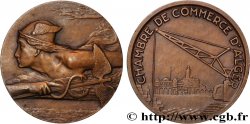正面
正面的文字 NAPOLEON III EMPEREUR.
正面的说明书 Buste de Napoléon III à gauche signé CAQUÉ F..
背面
背面的文字 QUO NON HAC DUCE À L'EXERGUE XV VIRI BURDIGALENSES COMMERCIIS REGENDIS.
背面的说明书 La poupe de vaisseau de Bordeaux portant la boussole signé A. DUBOIS.
背面的翻译 Jusqu'où ne va-t-on pas sous sa conduite? Les quinze commissaires de Bordeaux préposés à la conduite du Commerce.
历史细节
CHAMBERS OF COMMERCE / CHAMBRES DE COMMERCE
The first chamber of commerce was that of Marseille, created at the end of the 16th century. For Paris, the six corps of merchants and the judge-consuls had a role similar to that of a chamber of commerce: an association of merchants gathered to deliberate on the interests of their city or region and to give their opinion to the government. Colbert legalizes them in 1664 by establishing that each place of commerce will choose two of them to represent them. However, the institution was not really established until the decision of the Council of August 30, 1701, and many chambers of commerce appeared in the 18th century in Lyon, Rouen, Toulouse, Montpellier, Bordeaux, etc. The most important of them is Marseilles which had attributions in all the trade of Levant and was of the department of Foreign Affairs, the others concerned the General control of Finances. Abolished by the Constituent Assembly in 1791, the chambers of commerce were re-established under the Consulate. Since 1832, their recruitment is done by elections, they have become chambers of commerce and industry since 1898, grouped into 21 regional chambers.








 对产品描述纠错
对产品描述纠错 打印
打印 分享我的选择
分享我的选择 提问
提问 Consign / sell
Consign / sell
 产品介绍
产品介绍









